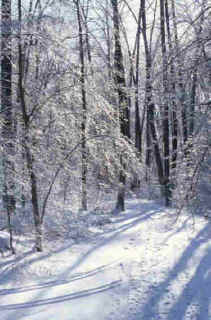|
Raindrops are formed when tiny droplets are enlarged,
first by moisture from the surrounding air condensing on them and then
by coalescing with other droplets during their descent. Raindrops vary
in size from about 0.02 in. (0.5 mm) to as much as 0.33 in. (8 mm) in
thunderstorms.
There are two main processes to form precipitation
in clouds. Coalescence is a warm rain process, cloud droplets
collide with each other and then coalesce (stick together) to form
larger droplets. Eventually the droplets grow large enough that they
become precipitation droplets. In the ice crystal process, ice particles
exist in a cloud along with supercooled water and the ice crystals grow
rapidly due to the differences between water and ice saturation vapor
pressures.
|

Snow is a form of precipitation
|